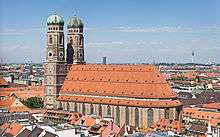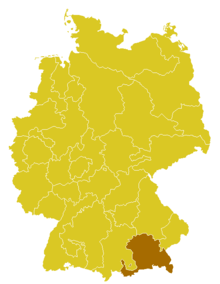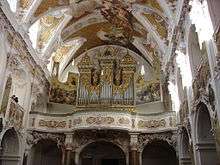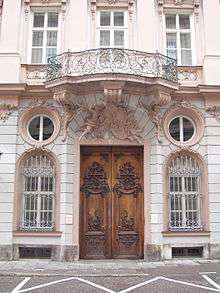Roman Catholic Archdiocese of Munich and Freising
| Archdiocese of Munich and Freising Archidioecesis Monacensis et Frisingensis Erzbistum München und Freising | |
|---|---|
 Frauenkirche, Munich | |
| Location | |
| Country | Germany |
| Ecclesiastical province | Munich and Freising |
| Metropolitan | Munich, Bavaria |
| Statistics | |
| Area | 11,998 km2 (4,632 sq mi) |
| Population - Total - Catholics |
(as of 2016) |
| Parishes | 747 |
| Information | |
| Denomination | Roman Catholic |
| Rite | Roman Rite |
| Established | 739 |
| Cathedral | Frauenkirche |
| Co-cathedral | Freising Cathedral |
| Patron saint | St. Corbinian |
| Current leadership | |
| Pope | Francis |
| Archbishop |
Reinhard Marx Archbishop of Munich and Freising |
| Auxiliary Bishops | Wolfgang Bischof, Bernhard Haßlberger |
| Emeritus Bishops | Friedrich Wetter, Franz Dietl |
| Map | |
 | |
| Website | |
| erzbistum-muenchen-und-freising.de | |



The Archdiocese of Munich and Freising (German: Erzbistum München und Freising, Latin: Archidioecesis Monacensis et Frisingensis) is an ecclesiastical territory or diocese of the Roman Catholic Church in Bavaria, Germany.[1][2] It is governed by the Archbishop of Munich and Freising, who administers the see from the co-cathedral in Munich, the Frauenkirche, which is never called in German Munich Cathedral. The other, much older co-cathedral is Freising Cathedral.
The see was canonically erected in about 739 by Saint Boniface as the Diocese of Freising and later became a prince-bishopric. The diocese was dissolved in 1803 following the collapse of the Holy Roman Empire, although a titular bishop ruled until April 1, 1818, when Pope Pius VII elevated the diocese to an archdiocese with its new seat in Munich, rather than Freising.
The archdiocese is divided into forty deaneries with 758 parishes. Its suffragan bishops are the Bishop of Augsburg, the Bishop of Passau, and the Bishop of Regensburg.
The most famous archbishop was Joseph Ratzinger, who was elected as Pope Benedict XVI.
Ordinaries
The following is a selection of notable ordinaries of the Bishopric and Prince-Bishopric of Freising and the Archbishopric and Archdiocese of Munich and Freising
Bishops of Freising
- Saint Corbinian (723–730; founded the Benedictine abbey in Freising, although the diocese was not organized until 739 by Saint Boniface)
- Erembert (739–747; sometimes referred to as Corbinian's half brother[3])
- Joseph of Freising, also known as Joseph of Verona (747–764)
- Arbeo (764–783)
- Atto (784–810)
- Hitto (811–834)
- Erchambert (835–854)
- Anno (855–875)
- Arnold (875–883)
- Waldo (883–903)
- Utto (903–907)
- Dracholf (907–926)
- Wolfram (926–937)
- Lantbert (937–957)
- Abraham (957–994)
- Gottschalk (994–1006)
- Egilbert of Moosburg (1006–1039)
- Nitker (1039–1052)
- Ellenhard, Count of Meran (1052–1078)
- Meginhard, Count of Scheyern (1078–1098)
- Heinrich I of Ebersdorf (1098–1137)
- Otto I (1138–1158)
- Albert I (1158–1184)
- Otto II (1184–1220)
- Gerold von Waldeck (1220–1230)
- Konrad I von Tölz und Hohenburg (1230–1258)
- Konrad II of Wittelsbach (1258–1278)
- Friedrich von Montalban (1279–1282)
- Emicho of Wittelsbach (1283–1311)
- In 1294, the Bishop's status as a prince of the Holy Roman Empire was confirmed.
Prince-bishops of Freising
- Gottfried von Hexenagger (1311-1314)
- Konrad III der Sendlinger (1314-1322)
- Johannes I Wulfing (1323-1324)
- Konrad IV von Klingenberg (1324-1340)
- Johannes II Hake (1340-1349)
- Albert II of Hohenberg (1349-1359)
- Paul von Jägerndorf (1359-1377)
- Leopold von Sturmberg (1377-1381)
- Berthold von Wehingen (1381-1410)
- Konrad V von Hebenstreit (1411-1412)
- Hermann von Cilli (1412–1421)
- Nicodemus of Scala (1421–1443)
- Sixtus of Tannberg (1474–1495)
- Ruprecht of the Palatinate (1495–1498)
- Philip of the Palatinate (1499–1541)
- Heinrich Pfalzgraf von Rhein (1541–1552)
- Leo Lösch von Hilkershausen (1552–1559)
- Moritz von Sandizell (1559–1566)
- Ernst, Duke of Bavaria (1566–1612)
- Albrecht Sigmund, Duke of Bavaria (1651–1685)
- Joseph Clemens Kajetan, Duke of Bavaria (1685–1694)
- Johann Theodor, duke of Bavaria (1727–1763)
- Klemens Wenzeslaus, Duke of Saxony(1763–1768)
- Joseph Konrad Freiherr von Schroffenberg (1790–1803). After his death, the temporal authority of the bishop was mediatised and abolished by the Elector of Bavaria.
- Joseph Jakob von Heckenstaller, priest, vicar capitular (1803-; was also named first a vicar general of the metropolite in Salzburg, and soon a papal delegate as "vicar capitular apostolic", but never raised to episcopacy). The episcopal functions were exercised by auxiliary bishop, Johann Nepomuk Wolf.
Archbishops of Munich and Freising
- Lothar Anselm Freiherr von Gebsattel (appointed 1818; confirmed soon, but at first only apostolic administrator; archbishop 1821; died 1846)
- Karl August Cardinal Graf von Reisach (succeeded 1 October 1846; resigned 19 June 1856)
- Gregor (Leonhard Andreas) von Scherr, O.S.B. (appointed 6 January 1856; died 24 October 1877)
- Antonius von Steichele (appointed 30 April 1878; died 9 October 1889)
- Antonius von Thoma (appointed 23 October 1889; died 24 November 1897)
- Franz Joseph von Stein (appointed 24 December 1897; died 4 May 1909)
- Franziskus Cardinal von Bettinger (1909–1917)
- Michael Cardinal von Faulhaber (1917–1952)
- Joseph Cardinal Wendel (1952–1960)
- Julius August Cardinal Döpfner (1961–1976)
- Joseph Cardinal Ratzinger (1977–1982)
- Friedrich Cardinal Wetter (1982–2007)
- Reinhard Cardinal Marx (2007; cardinal 20 November 2010)
Auxiliary Bishops
- Albertus, O.F.M. (1415–1442)[4]
- Johannes Frey, O.F.M. (1457–1474)[5]
- Johannes Berger, O.E.S.A. (1475–1481)[6]
- Erasmus Perchinger, O.F.M. (1482–1483)[7]
- Ulrich Pramberger, O.F.M. (1484–1494)
- Mathias Schach, O. Cart. (1495–1515)
- Konrad Mair (1517–1522)
- Augustin Mair, C.R.S.A. (1523–1527)
- Johann Peter Stoll, O.P. (1529–1548)
- Oswald Fischer (1548–1568)
- Sebastian Haidlauf (1569–1580)
- Bartholomäus Scholl (1581–1629)
- Johann Fiernhammer (1640–1663)
- Johann Kaspar Kühner (1664–1685)
- Simon Judas Thaddäus Schmidt (1687–1691)
- Johann Sigmund Zeller von und zu Leibersdorf (1692–1729)
- Johann Ferdinand Joseph von Boedigkeim (1730–1756)
- Franz Ignaz Albert von Werdenstein (1756–1766)
- Ernest Johann Nepomuk von Herberstein (Herbstein) (1767–1785)
- Johann Nepomuk von Wolf (1788–1802)
- Franz Ignaz von Streber (1821–1841)
- Johann Baptist von Neudecker (1911–1926)
- Ludwig Hartl (Harthl) (1921–1923)
- Michael Buchberger (1923–1927)
- Johann Baptist Schauer (1928–1942)
- Anton Scharnagl (1943–1955)
- Johannes Baptist Neuhäusler (1947–1973)
- Mathias Dionys Albert Paul Defregger (1968–1990)
- Ernst Tewes, C.O. (1968–1984)
- Franz Xaver Schwarzenböck (1972–1998)
- Heinrich von Soden-Fraunhofen (1972–1993)
- Engelbert Siebler (1986–2012)
- Bernhard Hasslberger (Haßlberger) (1994– )
- Franz Dietl (1998–2010)
- Wolfgang Bischof (2010– )
Residence
The residence of the Archbishops of Munich and Freising is the Palais Holnstein in Munich.
See also
References
- ↑ "Archdiocese of München und Freising {Munich}" Catholic-Hierarchy.org. David M. Cheney. Retrieved February 29, 2016
- ↑ "Metropolitan Archdiocese of München und Freising" GCatholic.org. Gabriel Chow. Retrieved February 29, 2016
- ↑ Maß, Josef (2005). "Der hl. Bonifatius und das Bistum Freising". Beiträge zur altbayerischen Kirchengeschichte (in German). 48: 9–27.
- ↑ "Bishop Albertus , O.F.M." Catholic-Hierarchy.org. David M. Cheney. Retrieved July 24, 2016
- ↑ "Bishop Johannes Frey, O.F.M" Catholic-Hierarchy.org. David M. Cheney. Retrieved July 24, 2016
- ↑ "Bishop Johannes Berger, O.E.S.A." Catholic-Hierarchy.org. David M. Cheney. Retrieved July 24, 2016
- ↑ "Bishop Erasmus Perchinger, O.F.M." Catholic-Hierarchy.org. David M. Cheney. Retrieved August 8, 2016
External links
- Roman Catholic Archdiocese of Munich (in German)
- Catholic Encyclopedia article (history of the diocese up to Archbishop von Bettinger)
Coordinates: 48°08′19″N 11°34′26″E / 48.13861°N 11.57389°E
